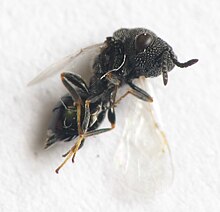Eurytomidae
| Eurytomidae | |
|---|---|

| |
| Bruchophagus roddi | |

| |
| Scientific classification | |
| Kingdom: | |
| Phylum: | |
| Class: | |
| Order: | |
| Suborder: | |
| Superfamily: | |
| Family: | Eurytomidae Walker, 1832
|
| Subfamilies | |
| Diversity | |
| Three subfamilies c.85 genera c.1420 species | |
The Eurytomidae are a family within the superfamily Chalcidoidea. The group is apparently polyphyletic, though the different subfamilies may each be monophyletic, and may be elevated to family status in the near future. As presently defined, some 1420 species in 87 genera are described.
Unlike most chalcidoids, the larvae of many are phytophagous (feeding in stems, seeds, or galls), while others are more typical parasitoids, though even then the hosts are usually found within plant tissues. They are found throughout the world in virtually all habitats, and a few are considered pests.
They tend to be dull and not metallic, and heavily punctured, with very thick, collar-like pronota, but none of these characters is unique within the Chalcidoidea, nor do they appear to define a natural group, and the family is likely to be divided.

External links
- Universal Chalcidoidea Database
- Cedar Creek Pinned specimen images.
- Philolema latrodecti (Fullaway) on the UF / IFAS Featured Creatures Web site
- Bugguide.net. Family Eurytomidae
